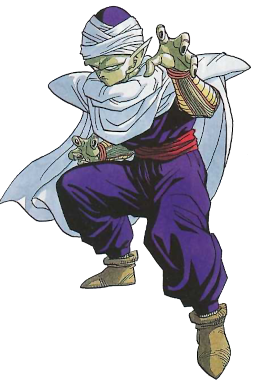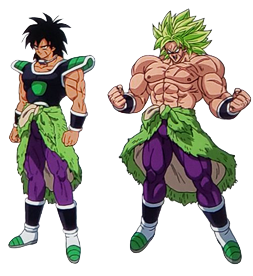
Son Gohan is a fictional character in the Japanese franchise Dragon Ball created by Akira Toriyama. Gohan is the first son of the protagonist Son Goku and his wife Chi-Chi and made his appearance in chapter #196 "Kakarrot", published in Weekly Shōnen Jump magazine on October 8, 1988.

Frieza, also known and spelled as Freeza in Funimation's English subtitles and Viz Media's release of the manga, is a fictional character and the primary antagonist in the Dragon Ball manga series created by Akira Toriyama. He makes his debut in Chapter #247: "Dark Clouds Swirl Over Planet Namek", first published in Weekly Shōnen Jump magazine on October 24, 1989, as the main antagonist of his eponymous saga, depicted as a galactic tyrant feared as the most powerful being in the universe.

Vegeta, fully referred to as Prince Vegeta IV, is a fictional character in the Japanese franchise Dragon Ball created by Akira Toriyama. Vegeta made his appearance in chapter #204 "Sayonara, Son Goku", published in Weekly Shōnen Jump magazine on January 7, 1989, seeking the wish-granting Dragon Balls to achieve immortality.

Piccolo is a fictional character in the Japanese Dragon Ball media franchise created by Akira Toriyama. He made his appearance in chapter #161 "Son Goku Wins!!", published in Weekly Shōnen Jump magazine on February 9, 1988, as the reincarnation of the evil King Piccolo, who was positioned as a demonic antagonist of the series. However, it is later revealed that he is in fact a member of an extraterrestrial humanoid species called Namekians from an exoplanet called Namek, those able to create the series' eponymous wish-granting Dragon Balls. After losing to Son Goku in the World Martial Arts Tournament, Piccolo teams up with him and his friends in order to defeat newer, more dangerous and powerful threats, such as Vegeta, Frieza, Cell, Majin Buu, Beerus, Zamasu, Jiren, Broly, and Moro. He also trains Goku's eldest son, Gohan, and the two form a very strong bond.

Krillin is a fictional character in the Dragon Ball manga series created by Akira Toriyama. He is introduced in chapter #25 "A Rival? Arrival!!", first published in Weekly Shōnen Jump magazine on May 21, 1985, as Goku's fellow martial arts student under Master Roshi. As the series progresses, Krillin becomes Goku's closest ally and best friend as he fights every villain along with Goku or before him and is often depicted as the comic relief.

Dragon Ball GT is a Japanese anime television series based on Akira Toriyama's Dragon Ball manga that ran from February 1996 to November 1997. Produced by Toei Animation, the series premiered in Japan on Fuji TV and ran for 64 episodes. Unlike Dragon Ball and Dragon Ball Z, the previous two television adaptations in the Dragon Ball media franchise, Dragon Ball GT does not adapt the manga by Toriyama. Dragon Ball GT is an anime-exclusive sequel to Dragon Ball Z with an original storyline using the same characters and universe, which follows the exploits of Son Goku, the series protagonist who is turned into a child; his granddaughter, Pan; and their associates on a quest to collect the Black Star Dragon Balls, a more powerful set of Dragon Balls which are hidden throughout the galaxy.

Son Goku is a fictional character and the main protagonist of the Dragon Ball manga series created by Akira Toriyama. He is based on Sun Wukong, a main character of the classic 16th-century Chinese novel Journey to the West, combined with influences from the Hong Kong action cinema of Jackie Chan and Bruce Lee. Goku made his debut in the first Dragon Ball chapter, Bulma and Son Goku, originally published in Japan's Weekly Shōnen Jump magazine on December 3, 1984. Goku is introduced as an eccentric, monkey-tailed boy who practices martial arts and possesses superhuman strength. He meets Bulma and joins her on a journey to find the seven wish-granting Dragon Balls. Along the way, he finds new friends who follow him on his journey to become stronger. As Goku grows up, he becomes the Earth's mightiest warrior and battles a wide variety of villains with the help of his friends and family, while also gaining new allies in the process.

Trunks is a fictional character in the Dragon Ball manga series created by Akira Toriyama. Within the series, he is the half-Saiyan half-human son of Vegeta and Bulma and has at least two noteworthy incarnations. Trunks makes his debut appearance in chapter #331 "The Young Boy of Mystery", first published in Weekly Shōnen Jump magazine on July 2, 1991, as an unidentified young man who traveled back in time to warn Son Goku and his allies of a deadly new enemy, the Androids of the Red Ribbon Army. This alternate future timeline incarnation of Trunks, who is usually referred to as "Future Trunks" in media to distinguish him from his present-timeline counterpart, is one of the Dragon Ball series' most popular characters and has been praised for his unique role within the series.

Dragon Ball Z: Fusion Reborn is a 1991 Japanese animated fantasy martial arts film and the 12th film in the Dragon Ball Z series. It was originally released in Japan on March 4 at Toei Anime Fair, and dubbed into English by Funimation in 2006. It was preceded by Dragon Ball Z: Bio-Broly and followed by Dragon Ball Z: Wrath of the Dragon.

Dragon Ball Z: Broly – The Legendary Super Saiyan is a 1993 Japanese anime science fiction martial arts film and the eighth Dragon Ball Z feature film. The original release date in Japan was on March 6, 1993, at the Toei Anime Fair alongside Dr. Slump and Arale-chan: N-cha! Clear Skies Over Penguin Village. It was dubbed into English and released by Funimation in 2003. It was preceded by Dragon Ball Z: Super Android 13! and followed by Dragon Ball Z: Bojack Unbound.

Dragon Ball Z: Super Android 13 is a 1992 Japanese anime science fiction martial arts film and the seventh Dragon Ball Z film. It was originally released in Japan on July 11 at the Toei Anime Fair along with the third Dragon Quest: Dai no Daibōken film and the Rokudenashi Blues film. Early concept art for the reissue used the title Android Assault, but the final product went back to using Funimation's original title for the film. It was preceded by Dragon Ball Z: The Return of Cooler and followed by Dragon Ball Z: Broly – The Legendary Super Saiyan.

Dragon Ball Z: Bojack Unbound is a 1993 Japanese animated science fantasy martial arts film and the ninth Dragon Ball Z feature film. It was released in Japan on July 10 at the Toei Anime Fair, where it was shown alongside Dr. Slump and Arale-chan: N-cha! From Penguin Village with Love and the first Yu Yu Hakusho film. The antagonist Bojack was created by Takao Koyama and was designed by series creator Akira Toriyama. The film is the last to feature Kōhei Miyauchi as Master Roshi, who died two years after its release. It was preceded by Dragon Ball Z: Broly – The Legendary Super Saiyan and followed by Dragon Ball Z: Broly – Second Coming.

Dragon Ball Z Trading Card Game is an out-of-print trading card game based on the Dragon Ball series created by Akira Toriyama. The game was produced by Score Entertainment and uses screen captures of the anime to attempt to recreate the famous events and battles seen in the anime. Score then sold the rights to Panini which eventually ceased publishing.

Broly is a fictional character in the Dragon Ball media franchise. Two different versions of the character exist: the original Broly, a major villain created by anime screenwriter Takao Koyama who appeared in a trilogy of 1990s Dragon Ball Z anime films, Broly – The Legendary Super Saiyan (1993), Broly – Second Coming (1994), and Bio-Broly (1994), followed by a newer and reworked version of the character by series creator Akira Toriyama that debuted in the film Dragon Ball Super: Broly (2018), where he initially served as one of the main antagonists, before eventually becoming a supporting character in his later appearances.

Dragon Ball: Yo! Son Goku and His Friends Return!! is a 35-minute Japanese animated short film based on Akira Toriyama's Dragon Ball series, shown on the Jump Super Anime Tour from September 21 to November 23, 2008. It was the first animated Dragon Ball film in twelve years, following the tenth anniversary film The Path to Power.

Dragon Ball Z Side Story: Plan to Eradicate the Saiyans is a 1993 card battle role-playing game developed by Tose and published by Bandai for the Family Computer game console. Based on the Dragon Ball franchise, the player's movement and battle choices are dictated by randomly generated playing cards.

Cell is a fictional character and antagonist in the Dragon Ball manga series created by Akira Toriyama. He makes his debut appearance in chapter #361 "The Mysterious Monster, Finally Appears!!", first published in Weekly Shōnen Jump on 16 February 1992. Cell is an evil artificial life form created using the DNA and cells from several significant strong characters in the series. He travels back in time from a different timeline so he can become a perfect being to defeat Goku. In order to reach this goal, he must absorb Androids 17 and 18, which have been killed in his timeline by Trunks.
Dragon Ball Z is a Japanese anime television series produced by Toei Animation. Part of the Dragon Ball media franchise, it is the sequel to the 1986 Dragon Ball television series and adapts the latter 325 chapters of the original Dragon Ball manga series created by Akira Toriyama. The series aired in Japan on Fuji TV from April 1989 to January 1996 and was later dubbed for broadcast in at least 81 countries worldwide.

Dragon Ball Xenoverse 2 is an action role-playing fighting game developed by Dimps and published by Bandai Namco Entertainment based on the Dragon Ball franchise, and is the sequel to the 2015 game Dragon Ball Xenoverse. It was released on October 25, 2016, for PlayStation 4 and Xbox One, and on October 27 for Windows. In Japan, Dragon Ball Xenoverse 2 was initially only available on PlayStation 4. The game was released for the Nintendo Switch in Japan on September 7, 2017, and later released worldwide on September 22, 2017. The game was released on Stadia on December 17, 2019.

















